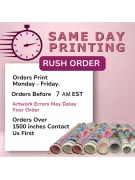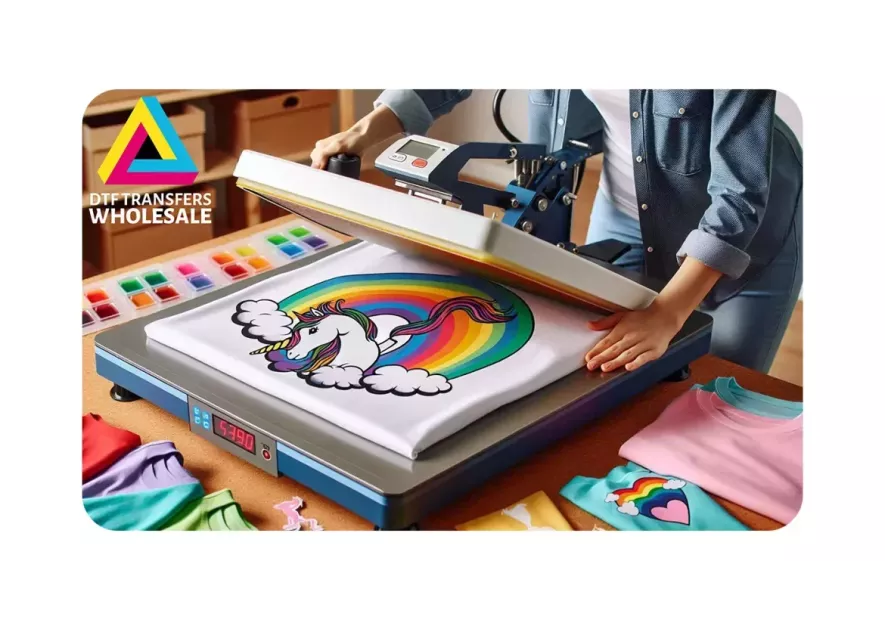How to Print DTF Transfers

Struggling with blurry prints and faded colors on fabrics? You're not alone. For many crafters and small business owners, the challenge of producing high-quality, durable prints on textiles can be a real headache.
It's frustrating when your creative vision gets lost in translation from design software to fabric. This is where mastering how to print DTF transfers changes the game.
If you've ever faced the disappointment of a print that just doesn't do justice to your original design, this guide is for you. We're going to show you the secrets of crisp, vibrant, and long-lasting prints with DTF technology. Say goodbye to mediocre prints, and get ready to see your designs come to life just the way you imagined them.
How do DTF Transfers Work?
Direct-to-film (DTF) transfer printing is a modern solution for printing vibrant and durable designs on various fabrics. Unlike traditional printing methods, DTF transfers involve printing your design onto a special film before transferring it onto the fabric. This process ensures that your design stays sharp, colorful, and long-lasting, even after multiple washes.
One key aspect of DTF transfers is the use of advanced DTF technology. This technology allows for a more precise application of ink which results in clearer and more defined images. Whether you're working on a complex, multi-colored design or a simple, bold logo, DTF transfers can handle it with ease.
For example, a local sports team's jerseys printed using DTF transfers will maintain their crisp logos and vibrant colors throughout the season, regardless of the number of washes or exposure to outdoor elements.
Another advantage of DTF printing is its versatility. It's suitable for a wide range of fabrics, from cotton and polyester to less common materials like silk or denim. This versatility opens up a world of creative possibilities for fashion designers, home crafters, and small business owners.
Equipment and Materials Needed
To start your journey in DTF printing, you'll need specific equipment and materials. The heart of the operation is a DTF printer, which is specially designed to handle the ink and film used in this process. These printers come in various sizes and capabilities to cater to different production needs.
For instance, a small home-based business might opt for a compact printer. While a larger operation might require a commercial-grade machine capable of handling higher volumes.
Next, you'll need the DTF film, a crucial component in this process. This film acts as the carrier for your design before it's transferred to the fabric. The quality of the film directly impacts the final print's clarity and durability, so opting for a high-quality film is essential.
In addition to the film, DTF printing requires special inks. These inks are formulated to adhere well to both the film and the fabric to ensure that your design stays put.
Another vital material is the powder adhesive. After printing your design onto the film, you'll apply this powder to it. The powder ensures that the ink adheres properly to the fabric during the transferring process.
Finally, a heat press is required to complete the transfer. The heat press applies the right amount of heat and pressure to transfer the design from the film to the fabric effectively. The choice of heat press can vary based on the size and scope of your projects.
For instance, a small, manually operated press might be sufficient for individual or small-scale projects, while larger operations might benefit from an automated, larger press.
Preparing Your Design
Before diving into the world of direct-to-film transfer printing, the first step is crafting a design that will look great on fabric. Start by choosing a design that is bold and clear. Complex designs can be stunning, but they need to be created with care to ensure every detail shows up well.
For instance, if you're designing a logo for a local coffee shop, make sure the text is legible and the coffee cup graphic is distinct.
How to Print DTF Transfers Using Direct-to-Film Techniques
When preparing your design, direct-to-film techniques come into play. These techniques involve considering the color contrasts and layering effects that work best on fabric.
Colors may appear differently on fabric than on your computer screen. For example, a vibrant green might need to be adjusted slightly to look just as lively when printed on a T-shirt.
Making the Most of Your Space with Gang Sheets
An efficient way to maximize your resources is to use gang sheets. This method involves printing multiple designs on a single DTF film sheet. It's particularly useful for bulk orders or when you're working with smaller designs, like logos or badges.
By arranging several designs on one sheet, you save both time and materials. Imagine you're creating a series of patches for a local sports team. With gang sheets, you can print all the team members' numbers and the team logo on one sheet to make the process more streamlined.
Finalizing Your Design
Once your design is ready, do a final check to ensure everything is set for printing. Check the alignment, color accuracy, and size. Your design must be not only visually appealing but also suitable for the DTF printing process.
After this final review, your design is all set to be transformed from a digital masterpiece into a tangible, wearable piece of art.
The Printing Process
The printing process for DTF transfers begins with setting up your DTF printer correctly. This involves loading the DTF film into the printer and ensuring your design is properly aligned.
Effective direct-to-film strategies are key to successful printing. This includes selecting the right print settings for your specific design and film type. It's crucial to adjust the printer settings based on the color intensity and detail of your design.
Once your printer settings are adjusted, the next step is the actual printing. The printer will apply the design onto the DTF film using specialized DTF inks. The ink is laid down in precise layers to create a vibrant and detailed image.
Curing and Transferring
After printing, the next step is curing the ink on the film. This process involves using a heat source to dry and set the ink onto the film. Proper curing is crucial as it ensures the ink is completely dry and firmly attached to the film.
With the ink cured, the film is now ready for the transfer stage. This is where the adhesive powder comes into play.
The powder is evenly applied over the printed design and then melted using a heat source. This melting process activates the adhesive and makes it ready to bond with the fabric.
The final step is transferring the design from the film to the fabric. This is done using a heat press, which applies heat and pressure to transfer the design. The heat press settings must be carefully adjusted to suit the type of fabric and the specifics of your design.
For example, transferring a complex graphic onto a delicate fabric like silk may require a lower temperature and less pressure than transferring onto a sturdier material like cotton.
Once the transfer is complete, the fabric is removed from the heat press, and the film is peeled away to reveal the finished design on the fabric. The result is a vibrant, detailed, and durable print that brings your design to life.
Tips for Success in DTF Transfers
Ensuring success in direct-to-film projects requires attention to detail and a good understanding of the process. Here are some tips to help you achieve the best results:
- Before committing to a large batch, print a test sample to check colors and design integrity
- Regularly check your DTF printer's ink levels to maintain consistent print quality
- Keep your printer and heat press clean and well-maintained to prevent any technical issues
- Invest in high-grade DTF films, inks, and powders for superior print outcomes
- Adjust the heat press settings according to the fabric type for optimal transfers
- Gently peel the film from the fabric after heat pressing to avoid distorting the design
- Store your DTF films and inks in a cool, dry place to preserve their quality
- Keep up with the latest direct-to-film techniques and advancements to refine your skills
- Experiment with different fabrics and designs to expand your DTF transfer capabilities
- Apply the same level of care and precision to each print for consistent quality
- Regularly ask for customer feedback to identify areas for improvement in your prints
- Keep your workspace organized to streamline the printing process and reduce errors.
Transform Your Ideas with DTF Transfers
Discovering how to print DTF transfers can help you unlock a whole new realm of creative potential. At DTF Transfers Wholesale, we take pride in providing the tools and expertise that help turn your visions into vivid, tangible realities. Our commitment to quality and innovation in DTF technology is unmatched, ensuring each project you undertake is not only successful but also a step towards mastering your craft.
Are you ready to enhance your printing projects with professional-grade DTF transfers? Contact Affordable DTF Transfers Near Me today, and let's create something extraordinary together.







Leave a comment